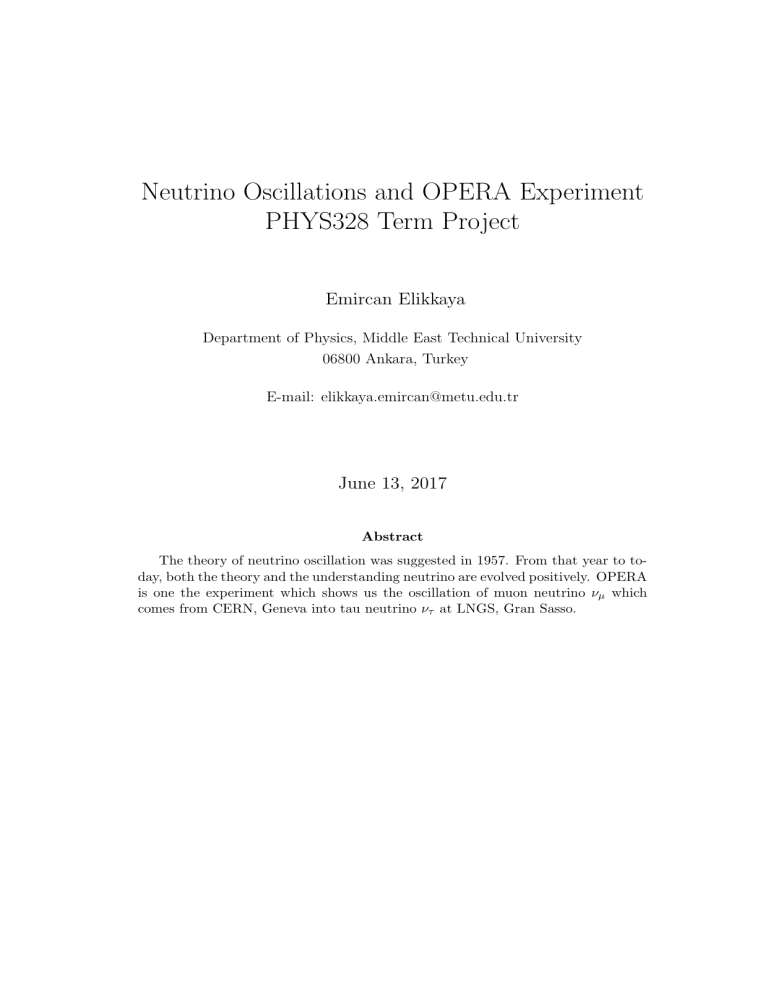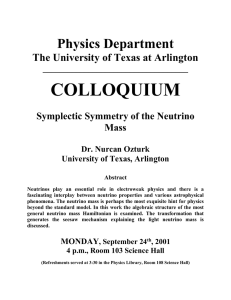
Neutrino Oscillations and OPERA Experiment PHYS328 Term Project Emircan Elikkaya Department of Physics, Middle East Technical University 06800 Ankara, Turkey E-mail: elikkaya.emircan@metu.edu.tr June 13, 2017 Abstract The theory of neutrino oscillation was suggested in 1957. From that year to today, both the theory and the understanding neutrino are evolved positively. OPERA is one the experiment which shows us the oscillation of muon neutrino νµ which comes from CERN, Geneva into tau neutrino ντ at LNGS, Gran Sasso. Contents 1 Introduction . . . . . . . . . . . . . . . . . . . . . . . . . . . . . . . . . . . . . 2 2 Neutrino Oscillations . . . . . . . . . . . . . . . . . . . . . . . . . . . . . . . 3 3 OPERA Experiment . . . . . . . . . . . . . . . . . . . . . . . . . . . . . . . 6 4 Conclusion . . . . . . . . . . . . . . . . . . . . . . . . . . . . . . . . . . . . . . 9 1 1 Introduction Neutrino is one of the most suprising particle from its discovery to today. The story was started with the discovery of radioactivity by H. Becquerel in 1986 [1, p.1]. From that year to today, there is a huge progress in nuclear and particle physics. In 1989, the story was continued with discovery of α-decay and β-decay by E. Rutherford and Curies [2, p.1]. The following year, discovery of γ-rays was achieved by P. U. Villard [1, p.1]. After the discoveries, people started to understand this behaviour of particles. In the year 1914, J. Chadwick demonstrated the difference between the spectrum of these particles [1, p.1]. The spectrum of β-particles is not a discrete value but a continous one, in contrast to α-particles and γ-rays. The questions about this anomaly have started to arise. Then, it could be answered after about 15 years, in 1930 by W. Pauli [3, p.24]. He thought there should be a particle to satisfy the conservation of energy, but also it should be chargeless to satisfy the conservation of charge principle. He had called his particle neutron at the beginning, but after the discovery of neutron by J. Chadwick in the year 1932[1, p.1], E. Fermi had gave the name to the particle neutrino which means little neutral in italian [3, p.24]. The idea of neutrino was quite interesting. Since it is neutral, detection of this particle was highly difficult. W. Pauli have explained this situation by its own words as ”I have done something very bad today by proposing a particle that cannot be detected; it is something no theorist should ever do.”[1, p.1]. After more than 20 years, people had a chance to observe the neutrino interaction. In 1956, the confirmation of the experiment done by C. L. Cowan and F. Reines [4]. They had observed the neutrino interactions which is between the flux coming from Savannah River Plant and the detector which is scintillator type. The reaction ν− + p+ → β + + n0 was employed in the experiment. After this result, people tought if there is another neutrinos we did not know yet. If there exist another neutrino flavors associated for each charged lepton, they can be observed too. In the following years, people tried to observe the rest.In the year 1962, L. Lederman, M. Schwartz, J. Steinberger have discovered the muon neutrino by using a spark chamber neutrino detector [5]. After that, in 2001, K. Niwa with DONUT collaboration have discovered the tau neutrino interactions by using nuclear emulsion method [6]. In addition to them, we know that neutrinos are oscillating from one flavor to another one. In the year 1957, B. Pontecorvo was first proposed the neutrino oscillations [1, p.4]. After that with the contribution of many others, the theory of neutrino oscillations was formed in 1976. For the following parts, neutrino oscillations and their observation in OPERA Experiment will be discussed in detailed, especially in section 2 and section 3. In section 4, conclusion of the paper will take part. 2 2 Neutrino Oscillations Neutrino interactions are difficult to observe. There are many experiments which examine the neutrino interactions. The Homestake experiment is one of them and has a big importance in terms of the evidence of neutrino oscillations. The experiment is designed to perform the measurement of the neutrinos which come from the sun and the experiment is designed with the help of standard solar model. The model which is formed by J. N. Bachcall in 1964 explains the neutrino production from the proton proton chain reaction in the sun[7]. In figure 1, the reaction is basically explained. Figure 1: PP chain overview (visual is taken from wikipedia, Proton-proton chain reaction article). With the help of standard solar model, R. Davis Jr. has designed an experiment to observe interaction of neutrinos coming from the sun[8]. They have started to take data in the year 1969 and continue it about 20 years. Even the probability of interaction is small, they have observed the interaction one of third from expected value. After long discussions, there was no answer neither from the theory nor from the experiment and this discrepancy is named solar neutrino problem. As mentioned before, in the year 1976, the theory which explains the neutrino oscillations was formed. According to the theory, the flavor eigenstate of a neutrino is determined by the mixture of ν1 , ν2 , and ν3 mass eigenstates. The theory is simple for any two flavor oscillation. If we handle a neutrino as να and another neutrino νβ case, we 3 can show the neutrino flavors as below; " # " να cos θ sin θ = νβ − sin θ cos θ #" ν1 ν2 # (1) Then, let us add the time dependence into the flavor eigenstate for νβ as; |νβ (0)i = − sin θ |ν1 i + cos θ |ν2 i (2) |νβ (t)i = − sin θ |ν1 i e−iE1 t/h̄ + cos θ |ν2 i e−iE2 t/h̄ (3) We can calculate the energies as; p Ex = p2x c2 + m2x c4 x = 1, 2 (4) By using the natural units where h̄ = c = 1, then the momentums become p1 = p2 = p, and the energies become; p Ex = p2x + m2x x = 1, 2 (5) By using the binomial expansion, we can write the energy as; s m2x 1 m2x 1 m2x Ex = p 1 + 2 = p 1 + + ... ≈ p 1 + p 2 p2 2 p2 x = 1, 2 (6) Then the flavor eigenstate becomes; −i(p+ |νβ (t)i = − sin θ |ν1 i e m2 1 )t 2p −i(p+ + cos θ |ν2 i e m2 2 )t 2p (7) Also, we can write it in the form; h 2 i m2 m2 1 −m2 1 |νβ (t)i = e−i(p+ 2p )t sin θ |ν1 i + cos θ |ν2 i ei( 2p )t (8) If we define the mass square difference as 4m2 = m21 − m22 , the time as t = x/c = x and the exponential term as z1 = (p + m21 /2p)t, we get; h i 4m2 |νβ (t)i = e−iz1 sin θ |ν1 i + cos θ |ν2 i ei 2p x (9) This is the final version of our flavor eigenstate. To calculate the oscillation probability, we can use the Equation 10 as; Pνβ →να = | hνα (0)|νβ (t)i |2 4 (10) Then the calculation step by step is; hνα (0)|νβ (t)i = e −iz1 − sin θ cos θ + sin θ cos θe i e 4m2 2p x (11) where hνi |νj i = δij The probability as; −iz1 iz1 Pνβ →να = e e 2 2 2 i 4m x 2p sin θ cos θ − 1 + e 2 −1+e i 4m x 2p (12) Doing the mid-steps, we get; Pνβ →να = sin2 (2θ) sin2 4m2 x 4p (13) Since the neutrinos are relativistic, we can assume Eν ≈ p and x is the base length L; Pνβ →να = sin2 (2θ) sin2 4m2 L 4E (14) Also, checking for the dimensional analysis at the final, we get; 4m2 L Pνβ →να = sin2 (2θ) sin2 1.27 4 Eν So the calculations for neutrino oscillations are done basically. 5 (15) 3 OPERA Experiment OPERA, Oscillation Project with Emulsion-tRacking Apparatus, is the experiment which searches for the neutrino oscillations. The experiment was placed in LNGS, Laboratori Nazionali del Gran Sasso, at Gran Sasso, Italy. By using CNGS Beam, Cern Neutrinos to Gran Sasso, which is high-intensity and high-energy beam of neutrino produced at CERN SPS, The Super Proton Synchrotron, in Geneva and towarding them to 730km away LNGS, the experiment was aimed to observe tau neutrino interactions with its detector. From 2008 to 2012, OPERA Experiment observes more than 15000 neutrino interactions [9]. Just 5 of them are recorded as tau neutrino ντ candidate. For the OPERA Experiment, the CNGS neutrino beam is designed and optimized carefully to study the νµ → ντ oscillation in appearance mode. At the beginning, 400GeV /c of proton beam from CERN SPS which includes about 2.0 × 1013 proton for a cycle is directed towards the CNGS target. This target includes a series of thin graphite rods. By this process, pions π and kaons K are produced and directed through the decay tube. After the decay of these particles, muons µ and muon neutrinos νµ are produced. At the last stage, the muon detectors detect the muons and the beam of muon and muon neutrino starts to travel to the LNGS. On the travel, the muons are absorbed in Earth and the rest is muon neutrinos [9]. On Figure 2, the schematic of the CNGS beam line and its steps are shown. Figure 2: Schematic of the CNGS beam line [9]. For the detection of neutrino interactions in OPERA Experiment, nuclear emulsion method is used to get high resolution tracking. By embedding the fine-grained silvedhalide crystals, AgBr, into a gelatine, the emulsion film is formed. These emulsion films are very similar to photographic films. When a charged particle pass through the film, it leaves a trace onto it. Within the method, most basic unit of the detector is produced. An emulsion layer about 43µm with another lead base layer about 205µm in series produces 6 the construction which is called an Emulsion Cloud Chamber (ECC) brick. In Figure 3, an image of ECC Brick takes place. Also in Figure 4, an image of tracks is shown. Figure 3: Emulsion Cloud Chamber (ECC) brick (visual is taken from lecture slides). Figure 4: Tracks in a brick and the process of selection step by step (visual is taken from lecture slides). Even the most important part of the detector is ECC bricks, to know the detection point, there should be another elements to locate the neutrino interaction. In general, as shown in Figure 5, the detector is a complex construction which has a lenght of 20 meters, height of 10 meters, width of 10 meters and weight of about 3ktons. It includes two identical main parts which are called supermodules (SM1, SM2). On the construction, each brick wall is followed by a target tracker produced by two scintillator plane, one as vertical the other as horizantal to get positining, to get the real-time observation. By detecting the charged particle from the decay, the position of the brick which includes the neutrino interaction is identified. At the head of the detector, a veto element is placed. Since the CNGS beam interacts with the environment before it reaches to the detector, there is some other secondary particles which does not wanted to observe in the detector. To eliminate these secondary particles, a veto element is placed at the head of the detector. 7 Figure 5: General view of OPERA Detector [9]. After the experiment is done, the analysis part is starting. Since the tracks on emulsions are very small to see them with eye, an automated scanning system is used. SuperUltra Track Selector in Japan and European Scanning System in Europe are two systems to analyze the emulsions by using optical microscopes. On Figure 6, an ESS microscope is shown. Using these systems, emulsions are analyzed and interactions are identified. Figure 6: An image of ESS microscope and its schematic view [9]. 8 4 Conclusion From discovery of the radioactivity to today, understanding and knowledge about neutrino and its interaction is evolved highly. Since understanding neutrino is quite relevant to understanding the universe, this progress is very important. Even neutrino is difficult to catch, there are many different types of experiments and studies. OPERA Experiment is one of them and a big project to make possible to observe muon neutrino νµ oscillate into tau neutrino ντ . Also, Turkey is one the participants of OPERA Collaboration with Middle East Technical University. The possibilities coming with this facility is quite important for neutrino studies. 9 References [1] W. C. Kim and C. Giunti, Fundamentals of Neutrino Physics and Astrophysics, Oxford University Press, 2007. [2] B. R. Martin, Nuclear and Particle Physics: An Introduction, John Wiley, 2009, 2nd Edition. [3] D. Griffiths, Introduction to Elementary Particles, Wiley-VCH, 2008, 2nd Revised Edition. [4] C. L. Cowan, F. Reines, F. B. Harrison, H. W. Kruse, A. D. McGuire, Science, 124, 103-104, 1956. [5] G. Danby, J-M. Gaillard, K. Goulianos, L. M. Lederman, M. Mistry, M. Schwartz, J. Steinbergert, Physical Review Letters, 9, 36-44, 1962. [6] K. Niwa et al., Physics Letters B, 504, 218-224, 2001. [7] J. N. Bahcall, Physical Review Letters, 12, 300-302, 1964. [8] R. Davis, Jr., Physical Review Letters, 12, 303-305, 1964. [9] A. Di Crescenzo, Search for νµ → ντ Oscillations in The OPERA Experiment. 10




